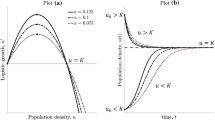Abstract
This paper develops a two-stage model for the optimal management of a potential invasive species. The arrival of an invasive species is modeled as an irreversible event with an uncertain arrival time. The model is solved in two stages, beginning with the post-invasion stage. Once the arrival occurs, the optimal path of species removal is that which minimizes the present value of damage and removal costs plus the expected present value of prevention costs. An expenditure-dependent, conditional hazard rate describing species arrival is developed based on discussions with natural resource managers. We solve for the optimal sequence of prevention expenditures, given the minimum invasion penalty as just described. For the case of the Brown Tree Snake potentially invading Hawaii, we find that pre-invasion expenditures on prevention are inverse U-shaped in the hazard rate. Efficient prevention should be approximately $2.9 million today and held constant until invasion. Once invasion occurs, optimal prevention requires $3.1 million annually and $1.6 million per year on species removal to keep the population at its steady state level, due to high search costs at very small population levels.
Similar content being viewed by others
References
Buhle ER, Margolis M, Ruesink JL (2005) Bang for buck: cost-effective control of invasive species with different life histories. Ecol Econ 52(3): 355–366
Burnett K (2007) Optimal prevention and control of invasive species: the case of the brown tree snake. Ph.D.Dissertation, University of Hawaii at Manoa
Burnett K, Kaiser B, Pitafi B, Roumasset J (2006) Prevention eradication and containment of invasive species: illustrations from Hawaii. Agric Resour Econ Rev 35(1): 63–77
Burnett K, Kaiser B, Roumasset J (2007a) Economic lessons from control efforts for an invasive species: miconiacalvescens in Hawaii. J For Econ 13(2–3): 151–167
Burnett K, Kaiser B, Roumasset J (2007b) Invasive species control over space and time: miconiacalvescens on Oahu, Hawaii. J Agric Appl Econ 39: 125–132
Burnett K, D’Evelyn S, Kaiser B, Nantamanasikarn P, Roumasset J (2008) Beyond the lamppost: optimal prevention and control of the brown tree snake in Hawaii. Ecol Econ 67: 66–74
Clark C (1990) Mathematical bioeconomics: the optimal management of renewable resources. 2. Wiley, Toronto
Costello C, McAusland C (2003) Protectionism trade and measures of damage from exotic species introductions. Am J Agric Econ 85(4): 964–975
D’Evelyn S, Tarui N, Burnett K, Roumasset J (2008) Uncertain populations and the value of information. J Environ Manag 89(4): 284–292
Eiswerth ME, Johnson WS (2002) Managing nonindigenous invasive species: insights from dynamic analysis. Environ Resour Econ 23(3): 319–342
Eiswerth ME, van Kooten CG et al (2007) Dynamic programming and learning models for management of a nonnative species. Can J Agric Econ 55(4): 485–498
Finnoff D, Tschirhart J (2005) Identifying preventing and controlling invasive plant species using their physiological traits. Ecol Econ 52(3): 397–416
Finnoff D, Shogren JF, Leung B, Lodge D (2005) The importance of bioeconomic feedback in invasive species management. Ecol Econ 52(3): 367–381
Greene WH (2000) Econometric analysis. Prentice Hall, Upper Saddle River
Horan RD, Lupi F (2005a) Economic incentives for controlling trade-related biological invasions in the Great Lakes. Agric Resour Econ Rev 34(1): 75–89
Horan RD, Lupi F (2005b) Tradable risk permits to prevent future introductions of invasive alien species into the Great Lakes. Ecol Econ 52(3): 289–304
Horan RD, Perrings C, Lupi F, Bulte EH (2002) The economics of invasive species management: biological pollution prevention strategies under ignorance. Am J Agric Econ 84(5): 1303–1310
Kiefer NM (1988) Economic duration data and hazard functions. J Econ Lit 26: 646–679
Knowler D (2005) Reassessing the costs of biological invasion: Mnemiopsis leidyi in the Black Sea. Ecol Econ 52(2): 187–199
Knowler D, Barbier E (2000) The economics of an invading species: a theoretical model and case study application. In: Perrings C,Williamson M, Dalmazzone S (eds) The economics of biological invasions. Edward Elgar, Cheltenham
Kraus F, Cravalho D (2001) The risk to Hawaii from snakes. Pac Sci 55(4): 409–417
Leung B, Finnoff D, Shogren JF, Lodge D (2005) Managing invasive species: rules of thumb for rapid assessment. Ecol Econ 55(1): 24–36
Margolis M, Shogren JF, Fisher C (2005) How trade politics affect invasive species control. Ecol Econ 52(3): 305–313
McAusland C, Costello C (2004) Avoiding invasives: trade-related policies for controlling unintentional exotic species introductions. J Environ Econ Manag 48(2): 954–977
McIntosh CR, Shogren JF, Finnoff DC (2007) Invasive species and delaying the inevitable: results from a pilot valuation experiment. J Agric Appl Econ 39: 83–95
Mehta SV, Haight RG, Homans FR, Polasky S, Venette RC (2007) Optimal detection and control strategies for invasive species management. Ecol Econ 61(2–3): 237–245
Olson LJ, Roy S (2005) On prevention and control of an uncertain biological invasion. Rev Agric Econ 27(3): 491–497
Olson LJ, Roy S (2008) Controlling a biological invasion: a non-classical dynamic economic model. Econ Theory 36(3): 453–469
Rodda GH, Sawai Y, Chiszar D, Tanaka H (eds) (1999) Problem snakemanagement: the Habu and the Brown Treesnake. Cornell University Press, Ithaca
Settle C, Shogren J (2002) Modeling native-exotic species within yellowstone Lake. Am J Agric Econ 84(5): 1323–1328
Stephens PA, Sutherland WJ, Freckleton RP (1999) What is the Allee effect? Oikos 87(1):185–190
Tsur Y, Zemel A (1998) Pollution control in an uncertain environment. J Econ Dyn Control 22: 967–975
Tsur Y, Zemel A (2004) Endangered aquifers: groundwater management under threats of catastrophic events. Water Resour Res 40: 1–10
Tsur Y, Zemel A (2006) Welfare measurement under the threat of environmental catastrophes. J Environ Econ Manag 52: 421–429
Author information
Authors and Affiliations
Corresponding author
Rights and permissions
About this article
Cite this article
Burnett, K., Pongkijvorasin, S. & Roumasset, J. Species Invasion as Catastrophe: The Case of the Brown Tree Snake. Environ Resource Econ 51, 241–254 (2012). https://doi.org/10.1007/s10640-011-9497-3
Accepted:
Published:
Issue Date:
DOI: https://doi.org/10.1007/s10640-011-9497-3




